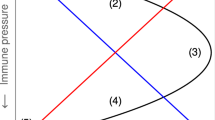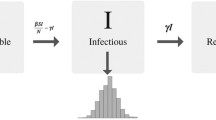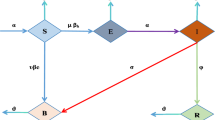Abstract
Although diseases such as influenza, tuberculosis and SARS are transmitted through an environmentally mediated mechanism, most modeling work on these topics is based on the concepts of infectious contact and direct transmission. In this paper we use a paradigm model to show that environmental transmission appears like direct transmission in the case where the pathogen persists little time in the environment. Furthermore, we formulate conditions for the validity of this modeling approximation and we illustrate them numerically for the cases of cholera and influenza. According to our results based on recently published parameter estimates, the direct transmission approximation fails for both cholera and influenza. While environmental transmission is typically chosen over direct transmission in modeling cholera, this is not the case for influenza.
Similar content being viewed by others
Explore related subjects
Discover the latest articles and news from researchers in related subjects, suggested using machine learning.References
Anderson RM, Donnelly CA, Ferguson NM, Woolhouse ME, Watt CJ, Udy HJ, MaWhinney S, Dunstan SP, Southwood TR, Wilesmith JW, Ryan JB, Hoinville LJ, Hillerton JE, Austin AR, Wells GA (1996) Transmission dynamics and epidemiology of BSE in British cattle. Nature 382(6594): 779–788
Ballesteros S, Vergu E, Cazelles B (2009) Influenza A gradual and epochal evolution: insights from simple models. PLoS One 4(10): e7426
Berglund N, Gentz B (2006) Noise-induced phenomena in slow–fast dynamical systems: a sample-paths approach. Springer, Berlin
Blanchong JA, Samuel MD, Goldberg DR, Shadduck DJ, Lehr MA (2006) Persistence of pasteurella multocida in wetlands following avian cholera outbreaks. J Wildl Dis 42(1): 33–39
Breban R, Drake J, Rohani P (2010) A general multi-strain model with environmental transmission: invasion conditions for the disease-free and endemic states. J Theor Biol 264(3): 729–736
Breban R, Drake JM, Stallknecht DE, Rohani P (2009) The role of environmental transmission in recurrent avian influenza epidemics. PLoS Comput Biol 5(4): e1000346
Caley P, Philp DJ, McCracken K (2008) Quantifying social distancing arising from pandemic influenza. J R Soc Interface 5(23): 631–639
Chowell G, Nishiura H, Bettencourt LMA (2007) Comparative estimation of the reproduction number for pandemic influenza from daily case notification data. J R Soc Interface 4(12): 155–166
Codeço C (2001) Endemic and epidemic dynamics of cholera: the role of the aquatic reservoir. BMC Infect Dis 1(1): 1
Codeço C, Lele S, Pascual M, Bouma M, Ko A (2008) A stochastic model for ecological systems with strong nonlinear response to environmental drivers: application to two water-borne diseases. J R Soc Interface 5(19): 247–252
Dennis B (1989) Allee effects: population growth, critical density, and the chance of extinction. Nat Resour Model 3(4): 481–538
D’Souza DH, Sair A, Williams K, Papafragkou E, Jean J, Moore C, Jaykus L (2006) Persistence of caliciviruses on environmental surfaces and their transfer to food. Int J Food Microbiol 108(1): 84–91
Fenichel N (1979) Geometric singular perturbation theory for ordinary differential equations. J Differ Equ 31(1): 53–98
Field H, Young P, Yob JM, Mills J, Hall L, Mackenzie J (2001) The natural history of Hendra and Nipah viruses. Microbes Infect 3(4): 307–314
Goldstein E, Dushoff J, Ma J, Plotkin JB, Earn DJD, Lipsitch M (2009) Reconstructing influenza incidence by deconvolution of daily mortality time series. Proc Natl Acad Sci USA 106(51): 21825–21829
Gralton J, Tovey E, McLaws ML, Rawlinson WD (2011) The role of particle size in aerosolised pathogen transmission: a review. J Infect 62(1): 1–13
Handel A, Longini IM, Antia R (2007) What is the best control strategy for multiple infectious disease outbreaks. Proc R Soc B 274(1611): 833–837
Henning J, Meers J, Davies PR, Morris RS (2005) Survival of rabbit haemorrhagic disease virus (RHDV) in the environment. Epidemiol Infect 133(4): 719–730
Jensen M, Faruque SM, Mekalanos JJ, Levin B (2006) Modeling the role of bacteriophage in the control of cholera outbreaks. Proc Natl Acad Sci USA 103(12): 4652
King AA, Ionides EL, Pascual M, Bouma MJ (2008) Inapparent infections and cholera dynamics. Nature 454(7206): 877–880
Li S, Eisenberg J, Spicknall I, Koopman J (2009) Dynamics and control of infections transmitted from person to person through the environment. Am J Epidemiol 170(2): 257–265
Miller MW, Hobbs NT, Tavener SJ (2006) Dynamics of prion disease transmission in mule deer. Ecol Appl 16(6): 2208–2214
Pascual M, Bouma M, Dobson A (2002) Cholera and climate: revisiting the quantitative evidence. Microbes Infect 4(2): 237–245
Pepper IL, Rusin P, Quintanar DR, Haney C, Josephson KL, Gerba CP (2004) Tracking the concentration of heterotrophic plate count bacteria from the source to the consumer’s tap. Int J Food Microbiol 92(3): 289–295
Reynolds KA, Watt PM, Boone SA, Gerba CP (2005) Occurrence of bacteria and biochemical markers on public surfaces. Int J Environ Heal R 15(3): 225–234
Roche B, Lebarbenchon C, Gauthier-Clerc M, Chang CM, Thomas F, Renaud F, van der Werf S, Guégan JF (2009) Water-borne transmission drives avian influenza dynamics in wild birds: the case of the 2005–2006 epidemics in the Camargue area. Infect Genet Evol 9(5): 800–805
Rohani P, Breban R, Stallknecht DE, Drake JM (2009) Environmental transmission of low pathogenicity avian influenza viruses and its implications for pathogen invasion. Proc Natl Acad Sci USA 106(25): 10365–10369
Roper MH, Vandelaer JH, Gasse FL (2007) Maternal and neonatal tetanus. Lancet 370(9603): 1947–1959
Rusin P, Orosz-Coughlin P, Gerba C (1998) Reduction of faecal coliform, coliform and heterotrophic plate count bacteria in the household kitchen and bathroom by disinfection with hypochlorite cleaners. J Appl Microbiol 85(5): 819–828
Sakamoto K (1990) Invariant manifolds in singular perturbation problems for ordinary differential equations. P Roy Soc Edinb A 116(1–2): 45–78
Spicknall IH, Koopman JS, Nicas M, Pujol JM, Li S, Eisenberg JNS (2010) Informing optimal environmental influenza interventions: how the host, agent, and environment alter dominant routes of transmission. PLoS Comput Biol 6(10): e1000969
Vardavas R, Breban R, Blower S (2007) Can influenza epidemics be prevented by voluntary vaccination?. PLoS Comput Biol 3(5): e85
Webb CT, Brooks CP, Gage KL, Antolin MF (2006) Classic flea-borne transmission does not drive plague epizootics in prairie dogs. Proc Natl Acad Sci USA 103(16): 6236–6241
Xiao Y, Bowers RG, Clancy D, French NP (2007) Dynamics of infection with multiple transmission mechanisms in unmanaged/managed animal populations. Theor Popul Biol 71(4): 408–423
Author information
Authors and Affiliations
Corresponding author
Rights and permissions
About this article
Cite this article
Breban, R. Role of environmental persistence in pathogen transmission: a mathematical modeling approach. J. Math. Biol. 66, 535–546 (2013). https://doi.org/10.1007/s00285-012-0520-2
Received:
Revised:
Published:
Issue Date:
DOI: https://doi.org/10.1007/s00285-012-0520-2




